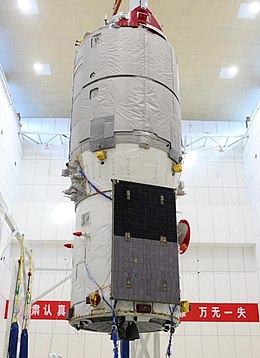 Tianzhou 2 cargo spacecraft prior to launch | |
| Manufacturer | CASC |
|---|---|
| Country of origin | |
| Operator | CMSA |
| Applications | Tiangong Space Station resupply |
| Specifications | |
| Spacecraft type | Automated cargo spacecraft |
| Launch mass | 13,500 kg (29,800 lb) (basic); 14,000 kg (31,000 lb) (improved) |
| Payload capacity | 6,900 kg (15,200 lb) (basic); 7,400 kg (16,300 lb) (improved) |
| Dimensions | 10.6 m × 3.35 m (34.8 ft × 11.0 ft) |
| Volume | 40 m3 (1,400 cu ft)[1] |
| Production | |
| Status | Active |
| On order | 1 |
| Built | 8 |
| Launched | 8 |
| Operational | 1 |
| Maiden launch | Tianzhou 1 |
| Last launch | Tianzhou 8 |
| Related spacecraft | |
| Derived from | Tiangong-1 |
| Powered by | 4× 490 N main engines, 32 attitude control engines (25, 120, 150 N thrust)[2] |
The Tianzhou (Chinese: 天舟; pinyin: Tiān Zhōu; lit. 'Heavenly Ship') is a Chinese automated cargo spacecraft developed from China's first prototype space station Tiangong-1 to resupply its modular space station. It was first launched (Tianzhou 1) on the Long March 7 rocket from Wenchang on April 20, 2017[3] and demonstrated autonomous propellant transfer (space refueling).[4][5]
The first version of Tianzhou has a mass of 13,500 kg and can carry 6,500 kg of cargo. Tianzhou-6 is the first improved version of the spacecraft to be launched into orbit; it has a mass of about 14,000 kg and can transport 7,400 kg of cargo.[6]
- ^ "天舟货运飞船到底长啥样 40立方米的货物舱共有208个货格" (in Simplified Chinese). 新華網. 2021-05-31. Retrieved 2022-11-13.
- ^ Lei, Jianyu; Jia, Dongyong; Bai, Mingsheng; Feng, Yong; Li, Xingqian (2023). "Research and Development of the Tianzhou Cargo Spacecraft". Space: Science & Technology. 3. doi:10.34133/space.0006. ISSN 2692-7659.
- ^ Cite error: The named reference
nsf-20160625was invoked but never defined (see the help page). - ^ Cite error: The named reference
copuos2016tech20Ewas invoked but never defined (see the help page). - ^ Clark, Stephen (17 September 2017). "Chinese space station freighter concludes refueling demo mission". Spaceflight Now. Retrieved 5 May 2018.
- ^ Jones, Andrew (10 May 2023). "Tianzhou-6 cargo spacecraft reaches China's Tiangong space station". spacenews.com. Retrieved 10 May 2023.